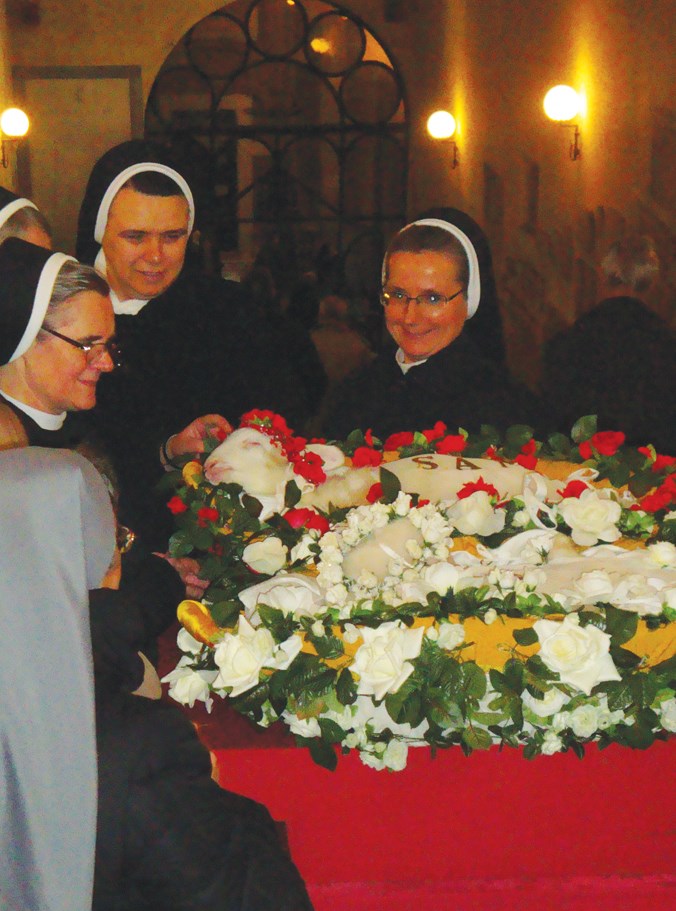No destination. I’ve wandered from our apartment near Rome’s Piazza Bologna, outside the old city walls and onto Via Nomentana, its lampposts decorated with Christmas lights, motorcycles whizzing by, and women shoppers out in their wintry finery, stylish cashmere and fur. With Christmas around the corner, the shopping is brisk this late afternoon.
Should I continue walking straight along the old Imperial route, or maybe duck into that imposing building off to the left? The noise of the traffic decides me, and I find myself passing through a great oak door and into a courtyard beyond. Just a 20-minute walk away from our apartment, and I’m in another world.
“Yaahaay! Wowww! Ragazzi! Fantastica!” The ragamuffin kids are yelling, kicking a soccer ball around in a fenced off yard near a church. It could be any field anywhere in Rome. I notice a girl trying to join in, looking teamless as she kicks her own ball on the sidelines.
They’re playing on the grounds of Santa Costanza church, a 4th century mausoleum built by Emperor Constantine (first Emperor to convert to Christianity) for his daughters. The building is round, small, intimate. It is perfectly preserved, surviving earthquake and wars. Its mosaics are superb and fully intact. Rumour has it Constantine’s elder daughter Constantia was a harridan, described as “fury incarnate” and her sanctification in the Middle Ages was due to her being mistaken for another, saintlier lady, Costanza. I like the muddle. Muddles make stories more human.
To the accompaniment of ragazzi hooting and hollering in the clear December air, I am joined by the same little girl, the outsider of the boys’ game. She’s fair haired and slender, this girl of about nine or ten, and she asks me what I’m doing here. Good question, I say. Her English is better than my Italian, so we alternate, with her giggling at my mispronunciations, correcting me, glorying in the role of teacher. Agnes – for such is my companion’s name – lives just over there. She points. She has the afternoon off school, she says. Would I like her to show me her church? I’m not given much choice – Agnes takes me by the hand, down the worn marble steps to the below street level entry.
She points to a huge mosaic in the centre dome, showing a saint holding a lamb. Saint Agnes, now I understand. This must be the church of Saint Agnese fuori le mura, where the patron saint of chastity lies buried. The sad story of this young girl of noble birth, who refused the advances of wealthy suitors, one of whom in a fit of pique, denounced her to the authorities as a Christian. As the story goes, the flames couldn’t consume the wood of the fire built to kill Agnes, so she was beheaded. But endings often tend to new beginnings. Less than a century later, Agnes was canonized and became the patron saint and protector of young girls.
My little guide, this modern-day Agnes, pleads with me to come back on Saint Agnes’ Feast Day. It’s in January. It’ll be so much fun, so pretty. And you’ll see me too. She is terribly excited trying to explain the event. And I’m not entirely clear about the tradition. I understand that every year in this church two lambs are … no, NOT sacrificed! She giggles. Blessed, she says, hooting with laughter and punching my arm.
I read up and make sure to mark the date in my calendar. It seems the coat of these lambs is afterwards shorn and woven into a vestment called a pallium and the pope sends a pallium to each newly appointed archbishop.
Jan. 21 rolls around and indeed, I see these oh-so-cute creatures lying under soft blankets covered by rose petals. I tentatively approach the wagon in which they lie. They look so still. Maybe I’d misunderstood what Agnes meant by this ceremony. I take a few steps back, on the brink of retreat, not wishing to look at dead lambs under rose petals on a wagon, being photographed by nuns. But I notice the blanket’s gentle rise and fall, and deduce the lambs are in fact alive, just very still. One wears a garland of white roses, the other red, I guess symbolizing Agnes’ purity and martyrdom.
The church is packed. A circle of nuns giddily snaps photos of the lambkins, as of course do I. At the height of the mass, six youngsters carry on their shoulders the wagon holding the lambs, proceeding to the altar, everyone craning their heads for a better view. I crane likewise, scanning the youngsters looking for my Agnes.
The lamb with the white garland awakens and starts bah’ing, and his white rose garland falls askew on his head, which adds to the charm. The bleating soon awakens his sibling, and the red rose garlanded lamb adds his bleats, so that from the one to the other, as if in contrapuntal harmony, bah’ing in stereophonic sound. The youngsters carrying the wagon bring it to rest in front of the high church altar, directly under the great apse, and the priest stands in his ceremonial vestments waiting behind the altar.
And now I see Agnes, my small new friend, slipping out from behind a gauze curtain. Like magic, perfectly timing her movements so the lambs in her care are not startled, Agnes lifts first one, then the other, so easily, so sweetly, and so very gently that one lamb licks her cheek. She kisses the lamb and holds it up to be blessed.



